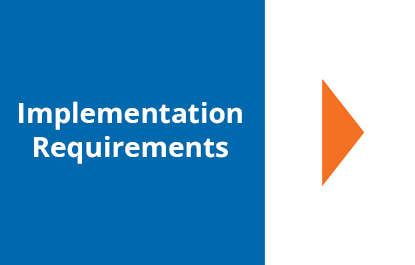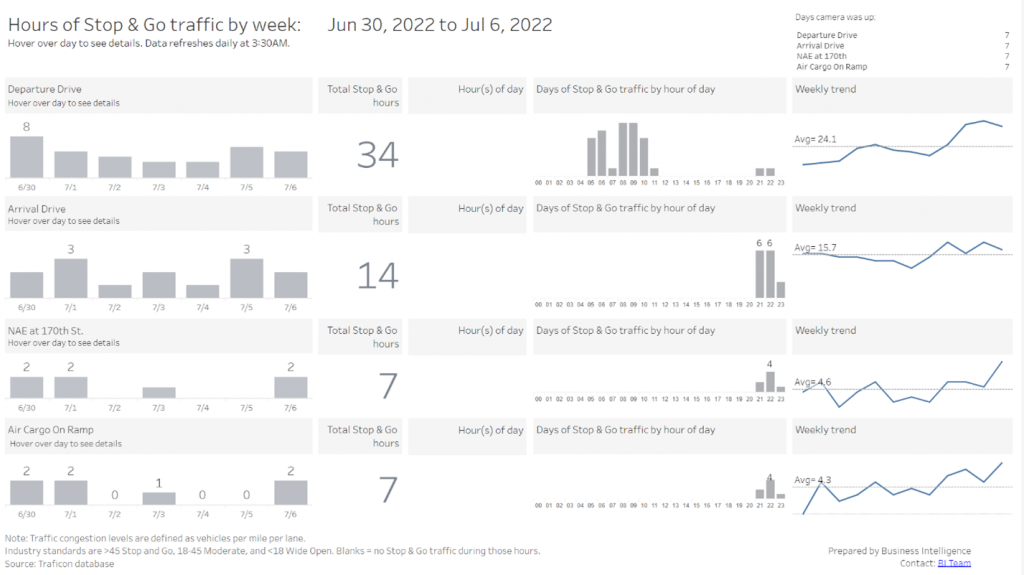Seattle-Tacoma International Airport
Monitoring Roadway Traffic to Reduce Congestion
The Seattle-Tacoma International Airport (SEA) is operated by the Port of Seattle. In 2021, SEA served 36 million passengers, with 374,510 takeoffs and landings, and 500,000 metric tons of air cargo handled. SEA provided $22.5 billion in regional economic impact and generated 151,400 jobs (87,300 direct) representing over $3.6 billion in earnings. A typical day at SEA consists of over 1,000 aircraft operations, 57,700 passengers screened by Transportation Security Administration, 43,900 vehicles in roadway traffic, and 5,430 ground transportation operations. The SEA data analytics team reports to the chief financial officer and is responsible for all external and internal data, synthesis, analysis, and interpretation. The analytics team leveraged data from an existing system of roadway cameras to monitor traffic congestion and predict travel times, and dashboards provided alerts about congestion and travel time estimates to internal teams.

Airport Demographics
Pacific Northwest U.S.
Port of Seattle
87,300 Employees
Data Analytics Capabilities at SEA

- SEA experienced an increase in passenger volume (2014 to 2015) from 20 to 40 million travelers annually.
- Increased traffic volume led to roadway congestion that impacted passenger travel times at the airport.
- The level of congestion was difficult to track without continuous measurement, particularly in the early morning and late at night.
- Management tasked the analytics team to leverage data to make congestion frequency and severity more actionable.

- An Intelligent Transportation System (ITS) of cameras and software provided traffic data for measuring congestion.
- Congestion is calculated by vehicle speed, density, and volume based on a formula developed with travel engineers.
- Data from the existing ITS was leveraged to estimate the number of passengers affected by severe congestion.
- Dashboards and visualizations for predicted travel times were deployed internally to operational teams.
- Alerts about congestion are sent out in real time.

Technical Requirements
- Intelligent system of cameras installed on the roadway and software that registers the counts of vehicles passing.
- Establishing data pipelines for recording the traffic data and storing the traffic data in a data warehouse.
- Analytics software to build data dashboards (Tableau, Alteryx) and data visualizations for a traffic alert system.
Human Capital Requirements
- Working with traffic engineers to get the right formulas for calculating traffic congestion.
- Communication and collaboration with internal stakeholders to get the needed buy-in for the approach.

Data and Technology Limitations
- Obtaining reliable actionable data and making sure that the numbers to be communicated are factually correct.
- Maintaining data credibility by comparing predicted travel time estimates to data scraped from Google Maps.
- Complex data analytics solutions are difficult to explain and more difficult for end-users to understand.
- Updating software systems to correct errors in traffic data and updating roadway cameras with a limited lifespan.

- Added value by using an existing ITS system in a new way to get actionable data on travel times and congestion.
- Simple data set can be leveraged to provide many different solutions to roadway traffic congestion.
- System alert messages about congestion sent out to internal teams in real time based on traffic thresholds.
- Ability to communicate travel times by holiday, day of week, and time of day based on checkpoints.
- Improved customer service by managing travelers’ expectations and the passenger experience.
Change Management Strategies
- Culture change: providing data literacy training to end users about how to use data and data alerts and being able to communicate with data and data visualizations.
- Getting buy-in from internal stakeholders and making sure the data solutions are reliable is critical as the aviation industry is generally slow in navigating change.
- Hiring talent and upskilling to advance the maturity of the data analytics program and provide services to staff with different data needs and pain points.
Greatest Challenges & Lessons Learned
Challenges
- Process automation and using analytics to optimize data flow have been pain points.
- Measuring roadway congestion based on density thresholds was more difficult for end-users and lay persons to understand than reporting traffic congestion in terms of passenger travel times.
Lessons
Impact to Organization
The SEA data analytics team leveraged data from an existing ITS camera system to obtain actionable data about traffic flows to estimate congestion, alleviate pressure on roadways, and reduce passenger travel times. The overall goal of the analytics team is to make sure the right information is available at hand to help a business or operational unit succeed by answering questions, solving problems, and creating a high level of customer service. The effective use of data analytics provided a standard of service that SEA communicates as steps taken to improve the experience of travelers at the airport.
Data Visualizations

Weekly Performance Summary Dashboard. SEA utilizes various dashboards including a weekly traffic report as seen above. This dashboard tracks weekly trends in traffic congestion data. Image credit: SEA

Live Congestion Alert. SEA staff receive live congestion reports when travel time reaches a certain threshold. Image credit: SEA